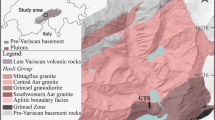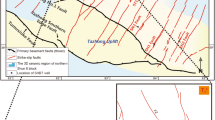Abstract
Bore holes were drilled in the Senonian limestone of the Hedils-Jalta area (northern Tunisia) in order to determine their potential as an aquifer. Structural, tectonic and hydrogeologic data compilation shows the discrimination of productive and not productive zones. Differential hydraulic productivity was recognised with four distinct productive geological zones separated by a sterile corridor trending NW–SE. The structure consists of two compressional dihedrons, limited by two conjugate strike-slip faults, trending NNE–SSW and nearly E–W. The reduction of the (1) potential reservoir, (2) the low hydraulic productivity of the central band, (3) the torsion of the fold axis in eccentric arcs on both sides of the compressive relay and (4) the differential hydrogeological zonation are all related to the distribution of stress in the interference zone between conjugate strike-slip faults and to the reorientation of the stress field in their vicinity. This study constitutes a main database in establishing strategies for groundwater exploration in the similar zones.
ملخّص
وقع إنجاز العديد من الآبارالعميقة في الأحجارالكلسيّة للعصرالطّباشيري الأعلى بمنطقة هذيل-جالطة الواقعة بشمال البلاد التّونسيّة، قصد تحديد ثرواتها المائيّة الجوفيّة. إنّ نضد التقسيمات البنيويّة و التكتونكيّة مع المعطيات الهيدروجيولوجيّة، تمكّن من تمييز مناطق منتجة وأخرى غير منتجة للمياه الجوفيّة. كما وقع تسجيل إنتاجيّة مائيّة تفاضليّة متكوّنة من أربعة مناطق جيولوجيّة منتجة متباينة يفصل بينها رواق عقيم ذو اتجاه شمال غرب-جنوب شرق. تتكوّن التركيبة البنيويّة من القسمين الضاغطين المحدودين بالفالقين الإنزلاقيّين والمترافقين، والمتجهان على التوالي شمال شمال شرق-جنوب جنوب غرب و قريب من شرق-غرب. إنّ انخفاض قوّة الخزن (1) وضعف الإنتاجيّة المائيّة(2) للشّريط الأوسط، والتواء محاورالجبال بالمناطق المجاورة لتتابع الإنكسارات المضغوطة (3) والتّباين الهيدروجيواوجي(4) جميعهم متّصلون بتوزيع حقل الضغط بمنطقة الإضطراب المتواجدة بين الفالقين الإنزلاقيّين و المترافقين وكذلك بإعادة توجّه حقل الضغط بالمساحات المجاورة للإنكسارات العميقة. إن هذه الدّراسة تشكل قاعدة بيانات وأداة مساعدة على إتّخاذ القرار في تأسيس إستراتجيات لاستكشاف المياه الجوفيّة بمناطق مماثلة.








Similar content being viewed by others
References
Batik P (1976) Carte géologique de la Tunisie au 1/50 000ème. Notice explicative de la feuille de Hédil., no. 11. Dir. des Min. et de la géol. Serv. Géol., Tunis
Ben ayed N (1986) Évolution tectonique de l’avant pays de la chaîne alpine de Tunisie du début du Mésozoïque à l’actuel. Thèse Doc. État, Univ. Paris Sud, France, 328 pp
Ben ayed N (1994) Les décrochements- chevauchements EW et NS convergents de la Tunisie septentrionale: géométrie et essai de reconstitution des conditions de déformations. Proceedings of the 4th Tunisian Petroleum Exploration Conference, E.T.A.P, Tunis, pp 25–35
Ben ayed N, Oueslati A (1988) Déformations tectoniques dans le Quaternaire récent de Ras Engela (région de Bizerte Tunisie septentrionale). Geol Mediterr 23:17–21 (France)
Ben mehrez F, Kacem J, Dlala M (2009) Late Cretaceous synsedimentary diapirism of Bazina–Sidi Bou Krime Triassic evaporites (northern Tunisia): geodynamic implications. Geodynamics, CR Geoscience 341:78–84
Burollet PF (1951) Étude géologique des bassins mio-pliocènes du Nord-Est de la tunisie. Ann. Mines et géol. (Tunis), no. 7, 94 pp
Castany G (1998) Hydrogéologie. Principes et Méthodes. Bordas, Paris, p 239
Cerepi A (2002) Analyse quantitative de l’hétérogénéité de la fracturation: application aux carrières souterraines. C R Geoscience 334:163–170
Chalbaoui M, Ben Dhia H (2004) Principales caractéristiques des réservoirs du Sud-Ouest tunisien. C R Geoscience 336:1191–1198
Chihi L (1995) Les fossés néogènes et quaternaires de la Tunisie et de la mer pélagienne. Etude structurale et leur signification dans le cadre de la géodynamique de la Méditerranée. Thèse Doc. Etat, Univ. Tunis II, 365 pp
Chikhaoui M, Braham A, Turki MM (2001) Preuves de la non-stratification du Trias dans le Turonien de la Koudiat Sidii (Nord-Ouest de la Tunisie). C R Acad Sci Paris, Sciences de la Terre et des planètes/Earth and Planetary Sciences 332:689–694
Crampon N (1972) Disposition et modalités de mise en place du complexe salifère de l’extrême nord-tunisien. C R Acad Sc Paris t 274:1625–1628
Crampon N (1973) Aperçu structural de la bordure des Mogods, du pays de Bizerte et du Nord des Hédil (Tunisie septentrionale). C R Acad Sci Série D 276(3):269–272
Cooper HH, Jacob CE (1946) A generalized graphical method for evaluating formation constants and summarizing well field history. Am Geophys Union Trans 27:526–534
De Marsily G (1981) Hydrogéologie quantitative. Masson, Paris, p 215
Detay M (1993) Le forage d’eau, Réalisation, entretien, réhabilitation. Masson, Paris, p 379
Dlala M (1992) Sismotectonic study in northern Tunisia. Tectonophysics 209:171–174
Dlala M (1994) Evidence for interchange (σ1/σ2) and its geodynamics implication in northeastern Tunisia. Africa Geoscience Review 1(4):533–545
El Euchi H (1996) Structural styles and tectonic habitats in northern Tunisia. Proceedings of the 5th Tunisian Petroleum Exploration Conference, E.T.A.P, Tunis, pp 123–132
El Euchi H, Fourati L, Hamouda F, Saidi M (1998) Structural style and hydrocarbon habitat in northern Tunisia. Field Trip Guide Book. ETAP mem., vol. 13. Tunis, Tunisia, 72 pp
Ennabli M (1967) contribution à l’étude hydrobiologique de la plaine de Mateur. Bureau de l’inventaire et de recherches hydrauliques, Septembre, 212 pp
Etchecopar A, Matauer M (1988) Méthodes dynamiques d’analyse des populations de failles. Bull Soc Géol France (8), t. IV, no. 2, pp 289–302
Fourati L, Hamouda F (1996) Abiod limestone reservoir characterization in Beja bloc (northern Tunisia). Proceedings of the 5th Tunisian Petroleum Exploration Conference, Mem. no. 10, E.T.A.P, Tunis, pp 363–380
Gouasmia M, Gasmi M, Mhamdi A, Bouri S, Ben Dhia H (2006) Prospection géoélectrique pour l’étude de l’aquifère thermal des calcaires récifaux, Hmeïma-Boujabeur (Centre ouest de la Tunisie). C R Geoscience 338:1219–1227
Gueddiche M, Harjono H, Ben Ayed N, Hfaied H, Diaments M, Dubois J (1992) Analyse de la sismicité et mise en évidence d’accidents actifs dans le Nord de la Tunisie. Bull Soc Géol France, t. 163, no. 4, pp 415–425
Guiraud M (1991) Réorientation de la contrainte horizontale σ1 sur décrochements. Un exemple: les décrochements sénestres NE–SW du bassin de la Haute-Bénoué (NW Nigeria). C R Acad Sci Paris, t. 313, Série II, pp 929–936
Kadri A, Ben Haj Ali A (1999) Éléments de réflexion sur les linéaments tectoniques Est–Sud et Nord–Sud et les grabens associés en Tunisie septentrionale. Note Serv Géol Tunisie 65:131–140
Malo M, Moritz R, Dube B, Chagnon A, Roy F, Pelchat CH (2000) Base metal skarns and Au occurrences in the southern Gaspé Appalachians: distal products of a faulted and displaced magmatic-hydrothermal system along the grand Pabos-Restigouche fault system. Econ Geol 95:1297–11318
Masrouhi A, Ghanmi M, Ben Youssef M, Vila JM, Zargouni F (2007) Mise en évidence d’une nappe de charriage à deux unités paléogènes au plateau de Lansarine (Tunisie du Nord): définition d’un nouvel élément structural de l’Atlas tunisien et réévaluation du calendrier des serrages tertiaires. C R Geoscience 339:441–448
Mercier J, Vergely P (1999) Tectonique. 2ème édi. DUNOD, Paris, France, 206 pp
Mzali H, Gabtni H, Zouari H, Hadj Sassi M, Gharsalli J (2007) Evidence of N120 shear corridors and associated tectonic structures in northeastern Tunisia after geological and geophysical data. C R Geoscience 339:358–365
Perthuisot V (1978) Dynamique et pétrogenèse des extrusions triasiques en Tunisie septentrionale. Presses de l’École normale supérieure de Paris, Travaux du laboratoire de géologie, no. 12, 312 pp
Philip H, Andrieux J, Dlala M, Chihi L, Ben Ayed N (1986) Évolution tectonique mio-plio-quaternaire du fossé de Kasserine (Tunisie centrale). Bull Soc Geol Fr 8(4):559–568
Ramsay JG (1967) Folding and fracturing of rocks. Mc Gaw-Hill, New York, p 568
Rigo L, Garde S, El Euchi H, Bandt K, Tiffert J (1996) Mezozoic fractured reservoirs in a compressional structural model for the north-eastern Tunisian Atlasic zone. Proceedings of the 5th Tunisian Petroleum Exploration Conference, E.T.A.P, Tunis, pp 233–256
Rouvier H (1977) Géologie de l’extrême Nord tunisien tectoniques et paléogéographies superposées à l’extrémité orientale de la chaîne maghrébine. Thèse Doctorat ès Sc., Univ. P et M. Curie, Paris, France, 703 pp
Segall P, Pollard DD (1980) Mechanisms of discontinuous faults. J Geophys 85:4337–4350
Tanfous Amri D, Bedir M, Soussi M, Azaiez H, Zitouni L, Inoubli MH, Ben Boubaker K (2005) Halocinèse précoce associée au rifting jurassique dans l’Atlas central de Tunisie (région de Majoura-El Hfay). C R Geoscience 337:703–711
Theis CV (1935) The relation between the lowering of the piezometric surface and the rate and duration of discharge of a well using groundwater storage. Am Geophys Union Trans 16:519–524
Author information
Authors and Affiliations
Corresponding author
Rights and permissions
About this article
Cite this article
Mejri, Z., Hatira, N. & Ben Hamza, C. Hydrogeologic productivity in response to a conjugate compressive strike-slip relay: example of Sidi Bou Krime-Jalta area (northern Tunisia). Arab J Geosci 4, 189–197 (2011). https://doi.org/10.1007/s12517-009-0119-0
Received:
Accepted:
Published:
Issue Date:
DOI: https://doi.org/10.1007/s12517-009-0119-0




